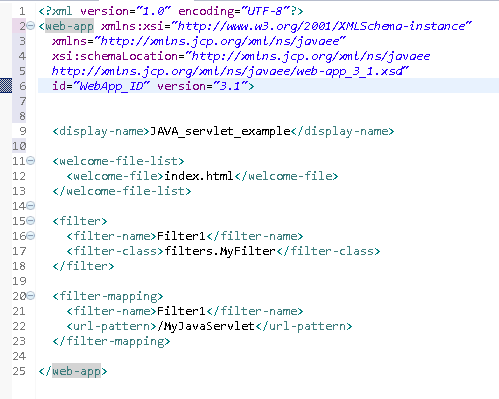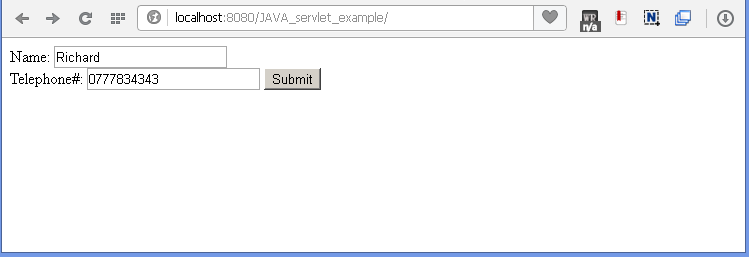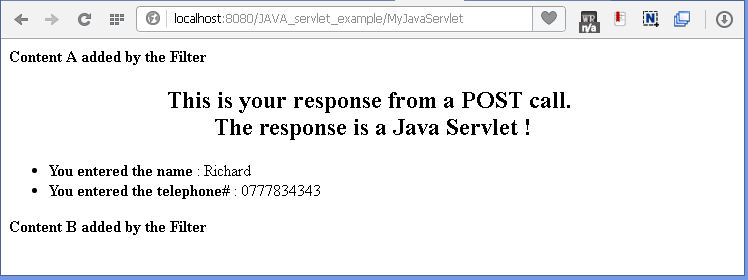#
Java Filters
This tutorial explains to you what a Java Filter is.
Servlet Filters are Java classes that can be used for intercepting requests from a client before they access a resource and for manipulating responses from server before they are sent back to the client. Filters perform filtering in the doFilter method. Every Filter has access to a FilterConfig object from which it can obtain its initialization parameters.
In the following example I will intercept a response and I will add some HTML content around the response HTML.
First, you have to create a HTML page. Let's define it as an index page into the Web Dynamic Project:
<!DOCTYPE html>
<html>
<head>
<meta charset="ISO-8859-1">
<title>From this page you call a Java servlet using POST Method</title>
</head>
<body>
<form action="MyJavaServlet" method="POST">
Name: <input type="text" name="name"> <br />
Telephone#: <input type="text" name="telephone" />
<input type="submit" value="Submit" />
</form>
</body>
</html>This file will be named index.html, and it is a simple HTML form.
Here is the web.xml file:

NOTES:
the name of the filter is not important for the configuration of the filter, but is important to understand why is created.
filter-class tag is used to point to the class (code) that implement that filter.
url-pattern tag is used to activate that filter for the Servlets that fit to that URL pattern.
if 2 filters will apply to a Servlet the order will be established by the filter mapping oredr in the web.xml file.
the Filters could be added or removed without changing the existing Java code.
And here is the code (the example) of my Java servlet which respond to a POST Method call :
package servlets;
import java.io.IOException;
import java.io.PrintWriter;
import javax.servlet.ServletException;
import javax.servlet.annotation.WebServlet;
import javax.servlet.http.HttpServlet;
import javax.servlet.http.HttpServletRequest;
import javax.servlet.http.HttpServletResponse;
/**
* Servlet implementation class MyJavaServlet
*/
@WebServlet("/MyJavaServlet")
public class MyJavaServlet extends HttpServlet {
private static final long serialVersionUID = 1L;
/**
* @see HttpServlet#HttpServlet()
*/
public MyJavaServlet() {
super();
// TODO Auto-generated constructor stub
}
/**
* @see HttpServlet#doPost(HttpServletRequest request, HttpServletResponse response)
*/
protected void doPost(HttpServletRequest request, HttpServletResponse response) throws ServletException, IOException {
// TODO Auto-generated method stub
PrintWriter myResponse = response.getWriter();
String message = "This is your response from a POST call. <br> The response is a Java Servlet !";
myResponse.println( "\n" +"<title> Example of using Java Servlet with POST Call Method !</title>\n" +
"\n" +
"<h2 align="\"center\"">" + message + "</h2>\n" +
"<ul>\n" +
" <li><b>You entered the name </b>: " + request.getParameter("name") + "\n" +
" </li><li><b>You entered the telephone# </b>: " + request.getParameter("telephone") + "\n" +
"</li></ul>\n" +
"");
}
}
Here is the code of the Java filter:
package filters;
import java.io.IOException;
import java.io.PrintWriter;
import javax.servlet.Filter;
import javax.servlet.FilterChain;
import javax.servlet.FilterConfig;
import javax.servlet.ServletException;
import javax.servlet.ServletRequest;
import javax.servlet.ServletResponse;
import javax.servlet.annotation.WebFilter;
/**
* Servlet Filter implementation class MyFilter
*/
@WebFilter("/MyFilter")
public class MyFilter implements Filter {
/**
* Default constructor.
*/
public MyFilter() {
// TODO Auto-generated constructor stub
}
/**
* @see Filter#destroy()
*/
public void destroy() {
// TODO Auto-generated method stub
}
/**
* @see Filter#doFilter(ServletRequest, ServletResponse, FilterChain)
*/
public void doFilter(ServletRequest request, ServletResponse response, FilterChain chain) throws IOException, ServletException {
// TODO Auto-generated method stub
// place your code here
response.setContentType("text/html");
PrintWriter resp = response.getWriter();
resp.println("<b> Content A added by the Filter </b>");
// pass the request along the filter chain
chain.doFilter(request, response);
resp.println("<b> Content B added by the Filter </b>");
}
/**
* @see Filter#init(FilterConfig)
*/
public void init(FilterConfig fConfig) throws ServletException {
// TODO Auto-generated method stub
}
}When you run the index page you will see :

And when you press the "Submit" button you will see the page generated by the servlet and modified by the filter :


